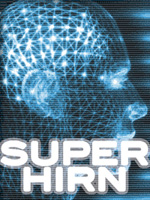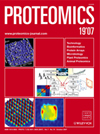Software:SuperHirn
From SPCTools
| Revision as of 10:00, 30 January 2009 Lmueller (Talk | contribs) (→About SuperHirn Parameters) ← Previous diff |
Revision as of 10:04, 30 January 2009 Lmueller (Talk | contribs) (→About SuperHirn Parameters) Next diff → |
||
| Line 92: | Line 92: | ||
| |- | |- | ||
| |INCLUSIONS LIST MS2 SCAN tolerance || Scan tolerance for annotation of MS1 features with inclusion list MS/MS identifications (# scans) || 100000 || - | |INCLUSIONS LIST MS2 SCAN tolerance || Scan tolerance for annotation of MS1 features with inclusion list MS/MS identifications (# scans) || 100000 || - | ||
| + | |- | ||
| + | | LC-MS Alignment: | ||
| + | |- | ||
| + | |retention time window || RT window to search for common MS1 feature across LC-MS runs before the alignment, i.e. maximal RT shift possible (min) || 5.0 || - | ||
| + | |- | ||
| + | |mass / charge window || Mass window to search for common MS1 feature across LC-MS runs before the alignment, i.e. maximal mass shift possible (ppm) || 20 || - | ||
| |- | |- | ||
| + | |||
| |} | |} | ||
Revision as of 10:04, 30 January 2009
Contents |
Description
SuperHirn is a novel tool to quantitatively analyze multi dimensional LC-MS data in a label-free approach and was developed by the group of Prof. Ruedi Aebersold at the Institute of Molecular Systems Biology (ETHZ, Switzerland). The software is programmed in C++ and is compatible with Unix platforms (tested on Linux and OSX). LC-MS data are preprocessed by a MS1 feature extraction routine and the different LC-MS runs are then combined by a multi dimensional LC-MS alignment into a general repository called MasterMap. SuperHirn then offers several modules for post data analysis of the MasterMap:
- LC-MS similarity analysis: Binary similarity analysis of LC-MS runs (intensity reproducibility, feature overlap)
- Feature intensity normalization: global MS1 feature intensity normalization across LC-MS runs
- Unsupervised feature profiling: Kmeans cluster analysis of MS1 features
- Targeted peptide/protein profiling: Correlate peptide/protein profile vs. a given target profile
- MS1 feature annotation: Annotation of MS1 features in the MasterMap (inclusion list etc.)
Avaliablity
The source code of SuperHirn can now be downloaded from the download page: go to download page
Supporting material to this software:
- For questions, suggestions and general comments visit the Google Groups "SuperHirn" .
- To access the benchmark Latin Square profiling data from the SuperHirn technical manuscript (Mueller et al.), follow this link.
- For more details about SuperHirn, please read the corresponding publication (Mueller et al.) or download the SuperHirn User Manual.
- For an example data set of SuperHirn, please download from this link: Example Test Set.
- For additional readings for experimental wetlab procedures in combination with SuperHirn data processing: Experimental Tips.
Reference
Software Article:
- Mueller, LN, Rinner, O, Schmidt, A, Letarte, S, Bodenmiller, B, Brusniak, MY, Vitek, O, Aebersold, R and Muller, M, SuperHirn - a novel tool for high resolution LC-MS based peptide/protein profiling, Proteomics, accepted for publication (2007) go to article
Applications of SuperHirn:
- Mueller, LN and Rinner, O, Hubálek, M, Müller, M, Gstaiger, M and Aebersold, R, An integrated mass spectrometric and computational framework for the comprehensive analysis of protein interaction networks, Nature Biotechnology 25, 345 - 352 (2007) go to article
- Bodenmiller, B, Mueller, LN, Mueller, M, Domon, B and Aebersold, R, Reproducible Isolation of Distinct, Overlapping Segments of the Phospho-Proteome. Nature Methods - 4, 231 - 237 (2007) go to article
- Rinner, O, Seebacher, J, Walzthoeni, T, Mueller, LN, Beck, M, Schmidt, A, Mueller, M, Aebersold, R, Identification of cross-linked peptides from large sequence databases. Nature Methods - 5, 315 - 323 (2008) go to article
- Schmidt A, Gehlenborg N, Bodenmiller B, Mueller LN, Campbell D, Mueller M, Aebersold R, Domon B., An integrated, directed mass spectrometric approach for in-depth characterization of complex peptide mixtures. MCP, 2008 Nov;7(11):2138-5 go to article
- Schiess R, Mueller LN, Mueller M, Wollscheid, B, Aebersold R, Analysis of cell surface proteome changes via label-free, quantitative mass spectrometry. MCP, 2008 Nov;7(11):2138-5 go to article
- Mueller LN, Brusniak M, Mani DR, Aebersold R, An assessment of software solutions for the analysis of mass spectrometry based quantitative proteomics data. J Proteome Res. 2008 Jan;7(1):51-61 go to article
- Urwyler S, Nyfeler Y, Ragaz C, Lee H, Mueller LN, Aebersold R, Hilbi H, Proteome analysis of Legionella vacuoles purified by magnetic immuno-separation reveals secretory and endosomal GTPases. Traffic 2008 Oct 29, AOP, go to article
- Letarte S, Brusniak M, Campbell D, Eddes J, Kemp C, Lau H, Mueller LN, Schmidt A, Shannon P, Kelly-Spratt, Vitek O, Zhang H, Aebersold R, Watts J, Differential Plasma Glycoproteome of p19ARF Skin Cancer Mouse Model Using the Corra Label-Free LC-MS Proteomics Platform. Clinical Proteomics, Volume 4, Numbers 3-4 / December, 2008, go to article
Developers
- Lukas N. Mueller (send email)
Other Stuff
Das SuperHirn:: http://www.youtube.com/watch?v=LPj6cfX_U9o
About SuperHirn Parameters
h5. Description about the most important SuperHirn parameters:
The following table describes the most important SuperHirn processing parameters. These are stored in the Root-Parameter file and mostly optimized for FT profile data. To modify a parameter, do as following:
1.) copy the parameter in this format to your param.def file:
MS1 retention time tolerance=1.0
2.) adjust the parameters as you wish:
MS1 retention time tolerance=2.0
3.) run SuperHirn 4.) if you do not need the parameter anymore, just delete it or comment it out by //MS1 retention time tolerance ...
h3. Parameters:
Other Compatible MS File Formats:
| Parameter name | Description | Suggested Value | Comment |
|---|---|---|---|
| GENERAL: | |||
| MS1 retention time tolerance | RT tolerance between MS1 features used for the alignment (min) | 1.0 | - |
| MS1 m/z tolerance | Mass tolerance between MS1 features used for the alignment (ppm) | 10 | - |
| MS2 PPM m/z tolerance | Mass tolerance for annotation of MS1 features with MS/MS identifications (ppm) | 20 | - |
| MS2 mass matching modus | if theoretical peptide mass (1) or precursor mass (0) used to mapp MS/MS ids to MS1 features | 0 | - |
| Peptide Prophet Threshold | Peptide Prophet Threshold, see peptide prophet paper | 0.9 | - |
| MS2 SCAN tolerance | Scan tolerance for annotation of MS1 features with MS/MS identifications (# scans) | 100 | - |
| MS2 retention time tolerance | RT tolerance for annotation of MS1 features with MS/MS identifications (min), if set to -1.0, then value from MS1 retention time tolerance parameter used | -1.0 | - |
| INCLUSIONS LIST MS2 SCAN tolerance | Scan tolerance for annotation of MS1 features with inclusion list MS/MS identifications (# scans) | 100000 | - |
| LC-MS Alignment: | |||
| retention time window | RT window to search for common MS1 feature across LC-MS runs before the alignment, i.e. maximal RT shift possible (min) | 5.0 | - |
| mass / charge window | Mass window to search for common MS1 feature across LC-MS runs before the alignment, i.e. maximal mass shift possible (ppm) | 20 | - |
| h6.General:|||
| h6.LC-MS Alignment:|||
|retention time window| RT window to search for common MS1 feature across LC-MS runs before the alignment, i.e. maximal RT shift possible (min)| 5.0 |-
|mass / charge window| Mass window to search for common MS1 feature across LC-MS runs before the alignment, i.e. maximal mass shift possible (ppm)| 20 |-
| h6.Peak Detection:|||
|MS1 external isotopic distribution file|Path to XML file containing external Isotopic Peptide Distributions, use only if abnormal peptide distributions expected| "" |-
|MS1 data centroid data| If MS1 data is in centroid (1) or raw (0) format| 0 |-
|Save MS/MS sequenced MS1 monoisotopic peaks| Option to keep detected Monoisotopic peaks which have been selected for MS/MS but do NOT fullfill the LC elution peak criteria (i.e. times detected, ∆RT between the detected peaks): on(1) or off(0)| 1 |-
|Precursor detection scan levels| MS scan from which level should be submitted for peak extraction, example for scan level 1 and 2: 1,2| 1 |-
|FT peak detect MS1 m/z tolerance| Mass tolerance to cluster detected monoisotopic peaks into RT elution clusters, i.e. MS1 featuers (ppm)| 10 |-
|MS1-to-MS2 precursor tolerance| Mass tolerance to associate MS/MS precursors to extracted mono isotopic peaks (ppm)| 15 |-
|FT peak detect MS1 min nb peak members| Minimal number of detected mono isotopic peaks for a MS1 featuer| 4 |-
|MS1 max inter scan distance| Maximal allowed RT distance between detected mono isotopic peak (min)| 0.2 |-
|FT peak detect MS1 intensity min threshold| Minimal intensity of a detected mono isotopic peak (counts)| 1000 |-
|Absolute isotope mass precision| Mass precision used in the detection of isotopic distributions (Da)| 0.01 |-
|Relative isotope mass precision| Mass precision used in the detection of isotopic distributions (ppm)| 10 |-
|IntensityCV| Coefficient of variance used to correlate a theoretical isotopic distributions to the observed one, i.e. the closer to one the better these two distributions need to coorelate | 0.9 |-
|Detectable isotope factor| At which % of the highest Isotope other isotopes to not need to be detected anymore | 0.1 |-
|Min. RAW MS Signal Intensity| Minimal intensity of a raw signal (before centroiding) | 10 |-
|Minimal peak height| Minimal intensity of a peak signal (after centroiding) | 0 |-
| h6.MS1 Feature Merging:|||
|Activation of MS1 feature merging post processing| Turn peak merging on(1) or off(0) | 1 |-
|PPM value for the m/z clustering of merging candidates| Mass tolerance to merge MS1 features (ppm) | 10 |-
|Initial Apex Tr tolerance| RT window to search for MS1 feature candidates which should be merged (min) | 5.0 |-
|MS1 feature Tr merging tolerance| Final RT tolerance for MS1 feature to be merged (min), measured from their start/end elution points | 1.0 |-
|Percentage of intensity variation between LC border peaks| Maximal log10 Intensity variation between start/end elution points of 2 features which should be merged | 50.0 |-
| h6.KMeans Profile Clustering Parameters :|||
|number of clusters| Number of initial start clusters, really depends on how many number of profile trends (or biological groups) you expect from your data | |-
|min. nb. of profile data points| How many profile points a MS1 features needs (same as how many times aligned) to be integrated into the clustering analysis | |-
|min. nb. of cluster members| How many members a build cluster needs minimally to survive the next clustering iteration | |-



